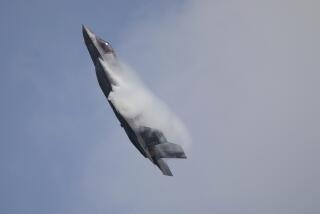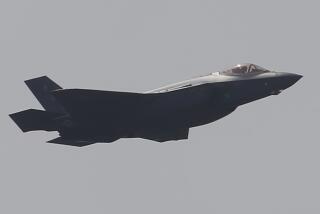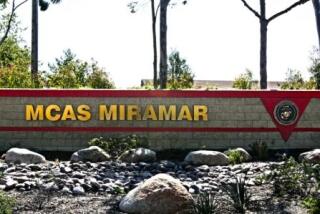No Apparent Reason for Ejecting : Jet Fighter Flies 700 Miles After Pilot Vanishes
- Share via
LONDON — A pilotless supersonic jet fighter flew 700 miles before crashing into the Atlantic after its civilian test pilot ejected for unexplained reasons, the Royal Air Force said Friday.
Searchers Friday found a body believed to be the pilot, Taylor Scott, who disappeared Thursday during a test of a new model of the Harrier GR-5 jump jet. It was to be the Harrier’s final test before delivery to the Royal Air Force.
Why the pilot ejected remained a mystery. He gave no warning of trouble before controllers lost radio contact with the plane as it flew over the city of Salisbury in southern England.
British air traffic controllers asked an American Air Force transport pilot, Capt. Jerry Brunz, to make radio contact with the Harrier pilot and take a look at the plane since it was close to the transport’s flight path. Brunz and his crew were flying to Dover Air Force Base, Del., from Mildenhall, England.
“We discovered there was no canopy and no pilot,” Brunz said, adding that the seat was also missing. “They requested we stay with the aircraft until it ran out of fuel.”
Brunz flew his C-5A alongside the fighter for about an hour before it crashed into the sea. The two planes were traveling at about 500 m.p.h. at 31,000 feet, he added.
RAF Statement
“What happened to the pilot is a mystery. We can only assume a problem occurred and he was forced to eject, leaving the plane continuing to fly out over the Atlantic,” the RAF said in a statement.
An RAF spokesman added, in a reference to an old television series whose plots involved strange and mysterious happenings, “It’s a complete mystery that seems right out of ‘The Twilight Zone.”
The plane took off from Dunsfold in southern England. The Dunsfold facility is owned by British Aerospace PLC, which makes the Harriers.
The RAF said the plane remained on radar screens after radio contact with pilot was lost. The RAF said no distress call from the pilot was received.
Searchers in helicopters retraced the Harrier’s path without picking up any signal from the personal radio beacon attached to the pilot’s clothing. In emergencies, such beacons are supposed to periodically transmit a radio signal to guide rescuers.
The body was found in a field about 10 miles northwest of Salisbury. A life raft was discovered nearby.
The Harrier, which is capable of hovering like a helicopter, is also flown by the U.S. Marine Corps. The GR-5 version was jointly developed by U.S. aircraft maker McDonnell Douglas Corp. and British Aerospace.
More to Read
Sign up for Essential California
The most important California stories and recommendations in your inbox every morning.
You may occasionally receive promotional content from the Los Angeles Times.












